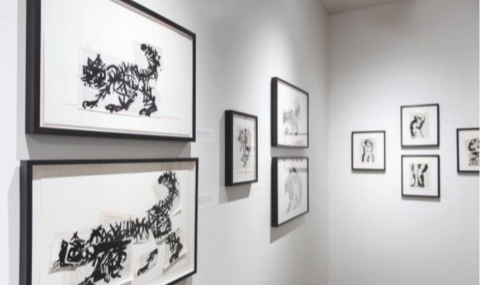South African artist William Kentridge is celebrated throughout the globe for his exploration of the intersection of printmaking, film, drawing and theater. Fairfield University’s Art Museum was provided with the opportunity to display Kentridge’s exhibition entitled, “William Kentridge: Universal Archive,” and housed a lecture followed by an opening reception of the exhibition on Wednesday Feb. 28. The exhibition is currently on display in the Walsh Gallery at the Regina A. Quick Center for the Arts.
Upon walking into the exhibition, viewers are greeted with more than 75 linocut prints that are printed on 1950s dictionary and encyclopedia pages – which Director of the International Print Center New York, Judy Hecker, explained are chosen randomly and the actual words on the pages hold no significant deeper meaning to the print itself.
As is the case for many artists, much of Kentridge’s inspiration stems from his personal experiences, including where he grew up – Johannesburg. As a witness to the dissolution of the apartheid, many of Kentridge’s work aims to translate political happenings into beautiful artworks for the public to view and interpret. “He is interested in the combination of political ambiguity and uncertain gestures in his work,” said Hecker.
The exhibition showcases pieces that depict familiar objects, such as coffee pots, trees, typewriters and birds. Interestingly enough, even though the viewer is able to tell what the artwork is resembling, Kentridge slightly abstracts them, making the viewer stare at the work for just a minute longer. For example, in one of his works he chose to combine a human body with a coffee pot. According to Hecker, this merging of objects relates to the artist’s skepticism towards certainty in creative processes.
Another interesting theme found in Kentridge’s “William Kentridge: Universal Archive,” is his repetition of objects. For example, the exhibition includes a series of trees. The recurring image ranges from complete realistic depictions of a tree to extremely loose brush strokes that barely resemble the image. It is within these groupings that the viewer can see Kentridge’s broad, expressive line work.
Some of the works on display are even created in a collage format. His “Horse” print is made with six different pieces of found dictionary paper, where each page holds a different portion of the horse. This same practice is echoed in various other pieces, including works depicting humans and other animals.
How these prints were made is by far the most striking part of this exhibition. Hecker explained that these grand prints were originally created as small ink drawings on dictionary pages in broad brush strokes. They were then glued onto linoleum blocks and carved through. Each image was then photo transferred and inked onto dictionary and encyclopedia pages. It’s important to note that when doing print transfers, it’s common for artists to use thicker papers, sometimes even with a fabric base. Kentridge’s decision to use extremely thin pages, like a dictionary, is risky as thin pages are prone to tearing easily.
This exhibition evokes the mind to contemplate ideas related to form, movement, politics and anything else that may occupy the mind of the observer. “William Kentridge: Universal Archive” is a travelling exhibition and is organized for tour by the Gund Gallery at Kenyon College. It is also made possible, in part, by contributions from Alva Greenberg ’74, the Gund Gallery Board of Directors and Ohio Arts Council. It will be on display in the Walsh Gallery until May 19 during regular visiting hours – Wednesday through Saturday 12-4 p.m.


Leave a Reply